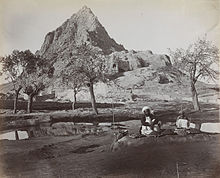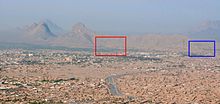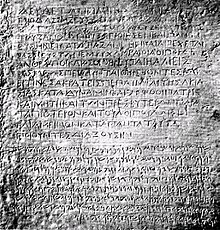 | |
| Coordinates | 31°36′55″N 65°39′49″E / 31.61528°N 65.66361°E |
|---|---|
| Type | Mountainous outcrop |


Chil Zena ("Forty steps"), also Chilzina or Chehel Zina, is a mountainous outcrop at the western limit of the city of Kandahar. Forty stone steps lead to the top of the outcrop, hence its name. It gives a commanding view on the city of Kandahar.[1] Chil Zena was located on the northern side of the old citadel of Old Kandahar, destroyed by Nadir Shah Afshar of Persia in 1738.[2] The carving of the staircase was commissioned by the Emperor Babur.[3] Chil Zena later received numerous inscriptions about the conquests of Babur (1526-1530), apparently carved by his son Humayun.[1]
Chil Zena is well known for the discovery of the Indian Emperor Ashoka's Kandahar Bilingual Rock Inscription on the mountainside, which is still located on in an open-air compound on the mountainside.[1] The presence of this inscription at Chil Zena helped confirm the presence of Greek populations in the vicinity in the 3rd century BCE, as well as the extent of Ashoka's control, which is therefore thought to have incorporated Kandahar and its region of Arachosia.[1]
References[edit]
- ^ a b c d e Dupree, L. (2014). Afghanistan. Princeton University Press. p. 286. ISBN 9781400858910. Retrieved 2016-11-27.
- ^ British Library Online
- ^ "Chilzina and the Forty Steps of Kandahar".

Well, that’s interesting to know that Psilotum nudum are known as whisk ferns. Psilotum nudum is the commoner species of the two. While the P. flaccidum is a rare species and is found in the tropical islands. Both the species are usually epiphytic in habit and grow upon tree ferns. These species may also be terrestrial and grow in humus or in the crevices of the rocks.
View the detailed Guide of Psilotum nudum: Detailed Study Of Psilotum Nudum (Whisk Fern), Classification, Anatomy, Reproduction